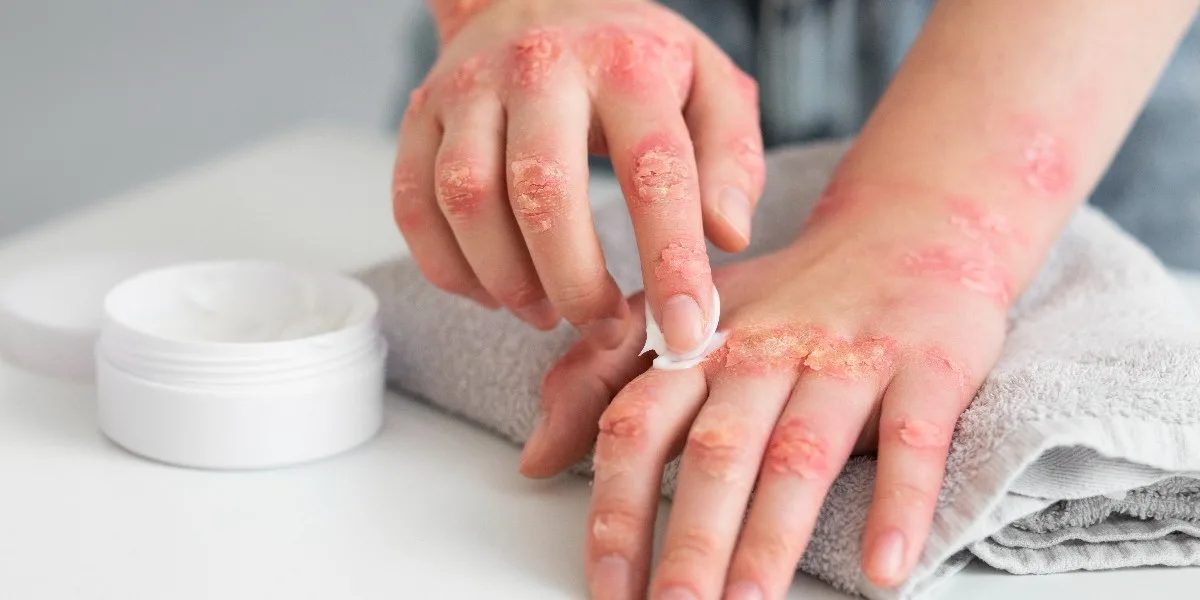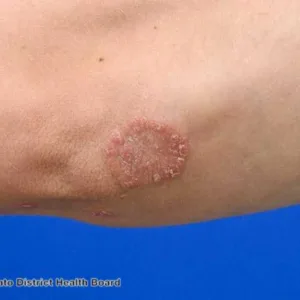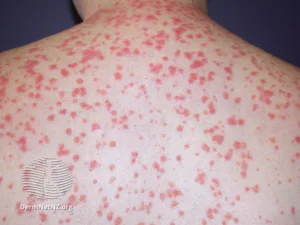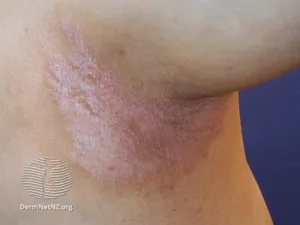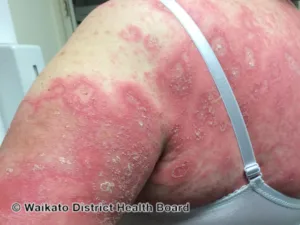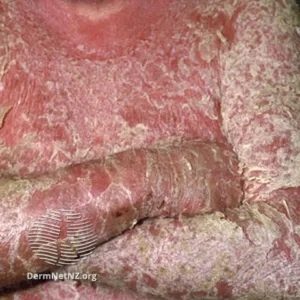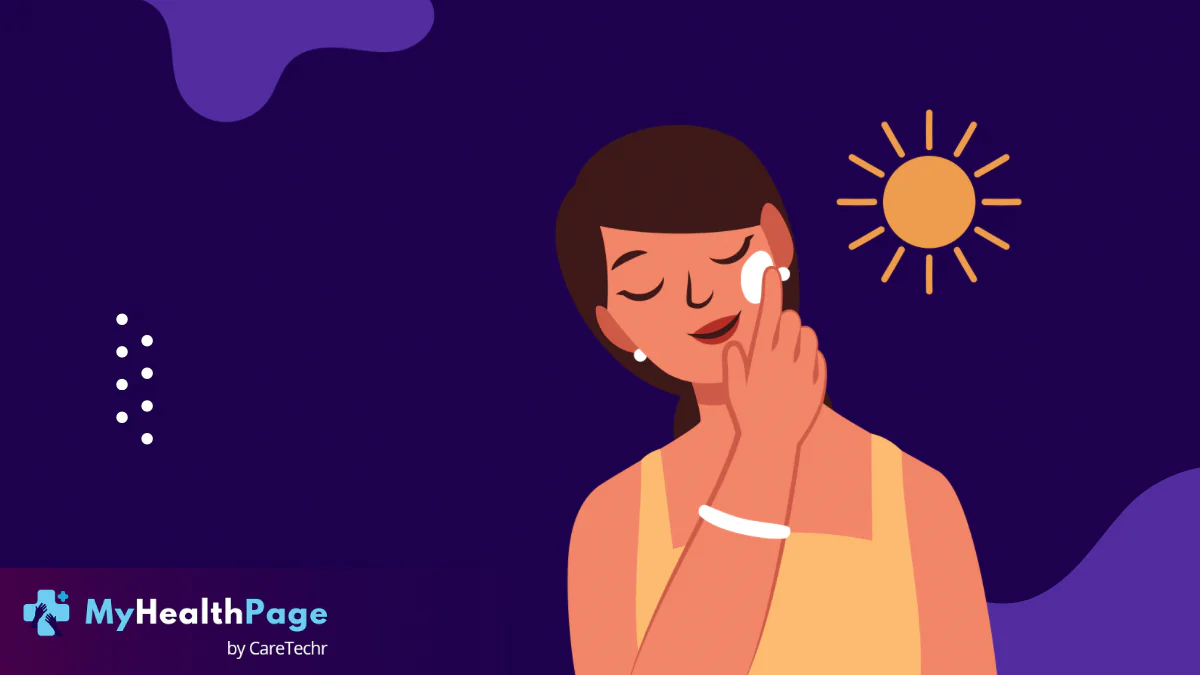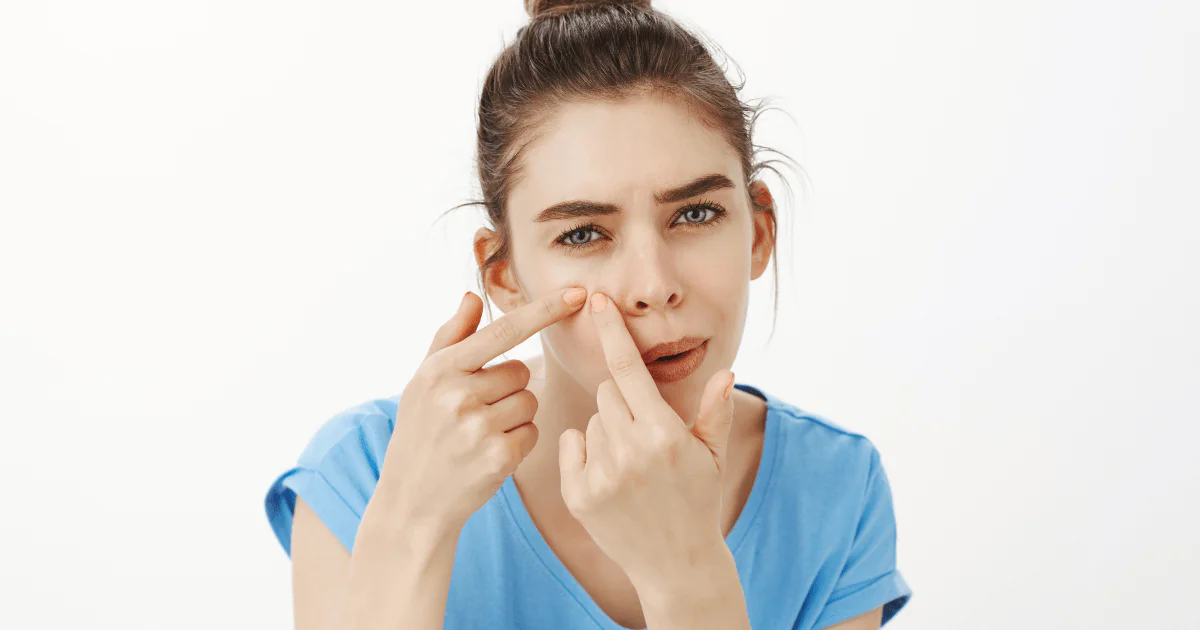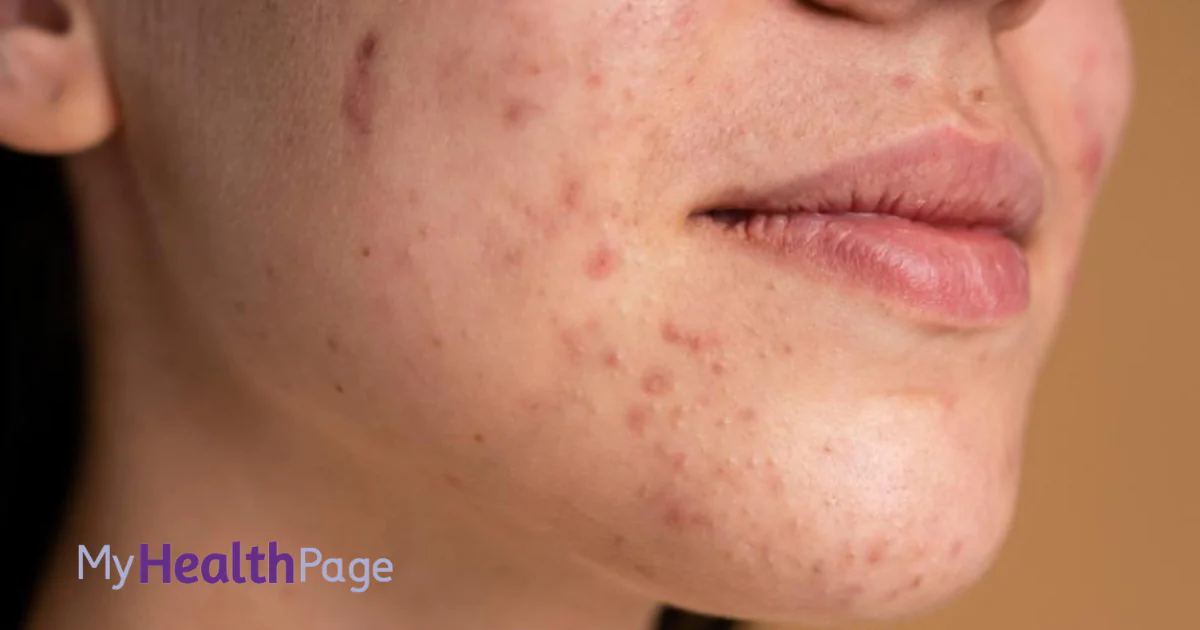1. Psoriasis Causes
Introduction: Psoriasis is recognized as an immune-mediated condition that significantly affects the skin. It manifests through a process where skin cells multiply faster than normal, leading to thick, white, silvery, or red patches of skin.
Genetic Factors: Genetics play a critical role in psoriasis. If one or both parents have psoriasis, the likelihood of their offspring developing the condition increases. Specific genetic mutations associated with psoriasis have been identified, contributing to the disease’s inheritance pattern.
Environmental Triggers: Several external factors can trigger psoriasis flare-ups. These include:
- Stress: High stress levels can initiate or worsen symptoms.
- Skin Injury: Cuts, scrapes, or severe sunburns can lead to the development of psoriasis patches on the injured skin, a phenomenon known as the Koebner response.
- Medications: Certain medications, including lithium, antimalarial drugs, and high blood pressure medications, can trigger psoriasis.
- Infections: Throat infections, particularly streptococcal infections, can lead to guttate psoriasis, especially in children.
Immune System: At the core of psoriasis is an overactive immune system. T cells, which are designed to protect the body, mistakenly attack skin cells, leading to rapid cell growth. This immune response causes inflammation and the overproduction of skin cells, resulting in the scaling and patches characteristic of the disease.
2. Psoriasis Symptoms
Psoriasis symptoms can vary greatly from person to person in both severity and form. However, there are common signs that typically indicate the presence of this skin condition.
Common Symptoms: The most identifiable symptoms of psoriasis include:
- Red Patches of Skin: These patches are often covered with thick, silvery scales and can be itchy or painful.
- Dry, Cracked Skin: Skin may bleed when it becomes severely dry.
- Itching, Burning, or Soreness: Affected areas may be intensely itchy or feel sore and burn, especially when scales are peeled away or during flare-ups.
- Thickened, Pitted, or Ridged Nails: Psoriasis can also affect fingernails and toenails, causing them to become pitted, thick, or detached from the nail bed.
Affected Areas: While psoriasis can occur on any part of the body, it’s most commonly found on the:
- Scalp
- Knees
- Elbows
- Trunk
- Limbs
Severity: The severity of psoriasis can fluctuate, with periods of few to no symptoms (remission) to times when the condition becomes worse (flare-ups). Severity is often classified into:
- Mild: Affecting less than 3% of the body.
- Moderate: Affecting 3% to 10% of the body.
- Severe: Affecting more than 10% of the body, which can significantly impact quality of life.
3. Psoriasis Types
Psoriasis manifests in several different forms, each with unique signs and symptoms. Understanding these types is crucial for effective treatment and management.
Plaque Psoriasis:
This is the most common form of psoriasis, affecting about 80-90% of people with the condition. It is characterized by raised, inflamed, red lesions covered with a silvery white buildup of dead skin cells, known as scales. These patches can appear anywhere on the body but are most commonly found on the knees, elbows, scalp, and lower back.
image by Dermnetnz
Guttate Psoriasis:
This type is more common in children and young adults and is often triggered by a bacterial infection such as strep throat. It appears as small, dot-like lesions, usually on the trunk, limbs, and scalp. Guttate psoriasis may resolve on its own, turn into plaque psoriasis, or come back in the plaque form.
image by Dermnetnz
Inverse Psoriasis:
Found in the body’s fold areas such as behind the knees, in the armpits, or under the breasts, this type is characterized by bright red, smooth (not scaly) patches. It can be particularly uncomfortable due to its location in sensitive and moisture-prone areas, making friction and sweating common triggers.
image by Dermnetnz
Pustular Psoriasis:
Less common than other types, pustular psoriasis is characterized by white pustules (blisters of noninfectious pus) surrounded by red skin. It can occur on any part of the body but is most often found on the hands or feet. Pustular psoriasis can be triggered by a variety of factors, including internal medications, overexposure to UV light, pregnancy, and stress.
Image by Dermnetnz
Erythrodermic Psoriasis:
This is a rare and severe form of psoriasis that affects most of the body’s surface. It is characterized by widespread, fiery redness and exfoliation of the skin, leading to severe itching and pain. Erythrodermic psoriasis can cause fluid and protein loss, leading to severe illness. This form of psoriasis can be life-threatening and requires immediate medical attention.
Image by Dermnetnz
Each type of psoriasis can vary in severity and duration, with symptoms lasting for weeks or months at a time and then diminishing or going into remission. Accurate diagnosis and appropriate treatment are essential for managing the condition effectively.
4. Psoriasis Scalp
Psoriasis can affect various parts of the body, but the scalp is one of the most common areas. Scalp psoriasis can range from mild, with slight fine scaling, to severe, with thick, crusted plaques covering the entire scalp. It can extend beyond the hairline onto the forehead, the back of the neck, and around the ears.
Symptoms and Appearance: Scalp psoriasis symptoms include:
- Red Areas of Skin Covered With Silvery Scales: The scales can be very fine or thick and crusted.
- Dry Scalp: The scalp may feel extremely dry, and scales can resemble dandruff.
- Itching and Soreness: Scalp psoriasis can be itchy, making it difficult to resist scratching. Scratching, however, can lead to bleeding and hair loss.
- Bleeding: Scratching or picking at the scales can cause bleeding.
- Burning Sensation or Soreness: The scalp may feel particularly tender.
Impact: Scalp psoriasis is not only physically troubling but can also affect emotional well-being and self-esteem. It can be particularly distressing due to its visibility and the social stigma associated with flaking and scaling. People with scalp psoriasis might feel self-conscious and avoid social situations or activities like swimming or going to the hairdresser.
5. Psoriasis Treatment / Treatment for Psoriasis on Scalp
Treating psoriasis involves reducing inflammation and clearing the skin. Treatments vary depending on the severity and type of psoriasis and the area of the body affected. Here’s an overview of the common treatments, with a focus on scalp psoriasis:
General Treatments:
- Topical Treatments: These include corticosteroids, vitamin D analogues, anthralin, topical retinoids, and calcineurin inhibitors, which can reduce inflammation and slow the growth of skin cells.
- Phototherapy: This involves exposing the skin to ultraviolet light under medical supervision, effective for plaque psoriasis and particularly beneficial when combined with topical treatments.
- Systemic Medications: For moderate to severe psoriasis, oral or injected medications that affect the entire body may be necessary. These include methotrexate, cyclosporine, and acitretin.
Scalp-Specific Treatments:
- Medicated Shampoos and Solutions: Shampoos containing coal tar, salicylic acid, or ketoconazole can help reduce scalp symptoms. They can be used in conjunction with other treatments.
- Topical Steroids: Effective in reducing inflammation and itchiness. They come in various forms such as foams, lotions, and solutions suitable for scalp application.
- Scalp Oil: Oils containing coal tar or salicylic acid can help soften psoriasis scales so they can be washed away more easily.
Lifestyle Changes and Home Remedies:
- Regular Washing: Using a suitable shampoo and routine can help to remove scales and calm inflammation.
- Moisturizing: Keeping the scalp moisturized can reduce dryness and flaking.
- Avoid Scratching and Picking: This can prevent exacerbation of symptoms and reduce the risk of infection.
- Stress Management: Stress is a known trigger for psoriasis flare-ups, so managing stress through techniques like meditation, yoga, or therapy can be beneficial.
Treatment for psoriasis can be a process of trial and error, requiring patience and persistence. A dermatologist can provide guidance on the most appropriate treatment options based on individual needs and the severity of the condition.
6. Psoriasis Medicine
The choice of medication for psoriasis depends on the type, severity, and location of the psoriasis, as well as the patient’s health history and preferences. Here are some commonly used medications for treating psoriasis:
Topical Medications:
- Corticosteroids: These are the most frequently prescribed medications for treating mild to moderate psoriasis. They reduce inflammation and relieve itching and are available in various strengths.
- Vitamin D Analogues: These synthetic forms of vitamin D slow down the growth of skin cells. Examples include calcipotriene (Dovonex) and calcitriol (Vectical).
- Anthralin: This medication slows cellular growth, but it can irritate skin and stain fabrics and skin.
- Topical Retinoids: These are vitamin A derivatives that help control skin cell growth. An example is tazarotene (Tazorac, Avage).
Systemic Medications:
- Methotrexate: Often used for people with severe psoriasis or psoriatic arthritis, this medication can slow cell turnover and suppress inflammation.
- Cyclosporine: This medication suppresses the immune system and is used for severe psoriasis or when other treatments have failed.
- Biologics: These drugs are designed to target specific parts of the immune system that trigger inflammation and result in the overproduction of skin cells. Examples include etanercept (Enbrel), adalimumab (Humira), and ustekinumab (Stelara).
Newer Treatments:
- Janus kinase (JAK) inhibitors: A newer class of medication, such as tofacitinib (Xeljanz), used for treating psoriasis and psoriatic arthritis by blocking certain enzymes in the immune system.
PDE4 Inhibitors:
- Apremilast (Otezla): This medication works by reducing the activity of an enzyme involved in the process of inflammation within the body.
It’s important to note that while these medications can be highly effective, they also come with potential side effects. Patients should discuss the benefits and risks of any medication with their healthcare provider and report any adverse reactions.
Related: Cystic Acne: A Complete Guide
Disclaimer : The information provided on this website/document is not a substitute for professional medical advice, diagnosis, or treatment. If you have any questions or concerns about your health, please consult with a licensed physician or other qualified healthcare provider.

